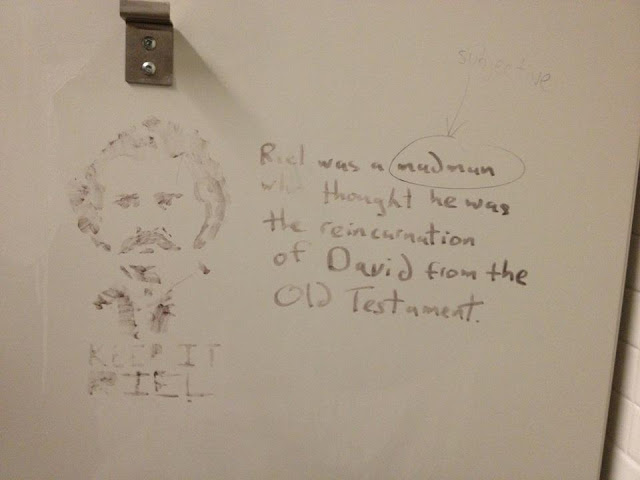The fluidity of street art fascinates me. One day it is there, the next it could be gone. The best part is the discourse that it can evoke, and I'm not talking about the aural one, but the multiplicity of artists (or hooligans or whatever you want to call them) who will react to each other's work. But maybe that's just an overly elegant way of saying people deface each other's defacements.
 | |||||
| Image taken from smurfun |
I want to get back to this idea of history on the streets or at least discourse through graffiti. My brother took this photo in a bathroom stall in the library at his university.
HOW AWESOME IS THIS?!?
I'm not getting into the debate about whether or not Riel was crazy, a traitor or a hero, what I want to talk about is how a student took this image of general support of Riel and his goals and has now 'made it Riel" by pointing out the unavoidable fact that Riel thought he was a prophet. We have the standard stencil of Keep it Riel. Which you can find on shirts, on walls, really all over. It looks to me like the person that scribbled this stencil also wrote: "Riel was a madman who thought that he was the reincarnation of David from the Old Testament." This is a really interesting twist on an image that I always assumed was a positive affirmation of support for what Riel was fighting for.
So we have the use of "Keep it Riel" twisted into pointing out a major character flaw and one of the most debated parts about Louis Riel. Then this gets even better! We have another person who clearly takes offense to the word 'madman' (fair enough) and circles it with a note that says: 'subjective.' This dialogue has now gone full circle because the pen-writer has remarked on the lack of authority that the stenciller now has. They lost their authority by being subjective or biased. This is pretty typical occurrence in history in public spaces because there is the assumption that there is fact and flasehoods. The pen-writer is making a claim of authority by essentially grading this graffiti, as a professor might, therefore denying their opinion. This negates the idea of Riel as a madman and although it brings the signification of the image back to its initial meaning, it also has a thicker meaning now simply because of a few scribbles.
So there you go! We have public history, street art, discourse, and authority claims all in one little photo!

